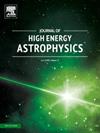Matter geometry coupling and Casimir wormhole geometry
IF 10.5
4区 物理与天体物理
Q1 ASTRONOMY & ASTROPHYSICS
引用次数: 0
Abstract
In this study, we investigate traversable wormhole solutions within the setup of gravity, a modified theory of gravity where the gravitational action relies upon the matter Lagrangian and the Ricci scalar R. In General Relativity (GR), stability issue in traversable wormholes necessitates the existence of exotic matter violating the null energy condition (NEC). In contrast, we explore wormhole solutions that align with the criteria for Casimir wormholes. Our analysis demonstrates that in the context of gravity, exotic matter can sustain these wormholes. We further examine the traversability conditions of the wormhole, considering both scenarios with and without the Generalized Uncertainty Principle (GUP) correction. Additionally, the stability of the wormhole is assessed based on equilibrium conditions. Our findings suggest that gravity offers a viable framework for the existence of stable, traversable wormholes sustained by exotic matter, potentially expanding the landscape of viable wormhole solutions beyond the confines of GR.
物质几何耦合和卡西米尔虫洞几何
在本研究中,我们研究了f(R,Lm)引力设置下的可穿越虫洞解,f(R,Lm)引力是一种修正的引力理论,其中引力作用依赖于物质拉格朗日量Lm和里奇标量R。在广义相对论(GR)中,可穿越虫洞的稳定性问题需要违反零能量条件(NEC)的奇异物质的存在。相比之下,我们探索符合卡西米尔虫洞标准的虫洞解决方案。我们的分析表明,在f(R,Lm)引力的背景下,外来物质可以维持这些虫洞。我们进一步研究了虫洞的可穿越性条件,考虑了有和没有广义不确定性原理(GUP)校正的两种情况。此外,根据平衡条件对虫洞的稳定性进行了评价。我们的研究结果表明,f(R,Lm)引力为由外来物质维持的稳定、可穿越的虫洞的存在提供了一个可行的框架,潜在地扩大了可行虫洞解决方案的范围,超出了GR的限制。
本文章由计算机程序翻译,如有差异,请以英文原文为准。
求助全文
约1分钟内获得全文
求助全文
来源期刊

Journal of High Energy Astrophysics
Earth and Planetary Sciences-Space and Planetary Science
CiteScore
9.70
自引率
5.30%
发文量
38
审稿时长
65 days
期刊介绍:
The journal welcomes manuscripts on theoretical models, simulations, and observations of highly energetic astrophysical objects both in our Galaxy and beyond. Among those, black holes at all scales, neutron stars, pulsars and their nebula, binaries, novae and supernovae, their remnants, active galaxies, and clusters are just a few examples. The journal will consider research across the whole electromagnetic spectrum, as well as research using various messengers, such as gravitational waves or neutrinos. Effects of high-energy phenomena on cosmology and star-formation, results from dedicated surveys expanding the knowledge of extreme environments, and astrophysical implications of dark matter are also welcomed topics.
 求助内容:
求助内容: 应助结果提醒方式:
应助结果提醒方式:


